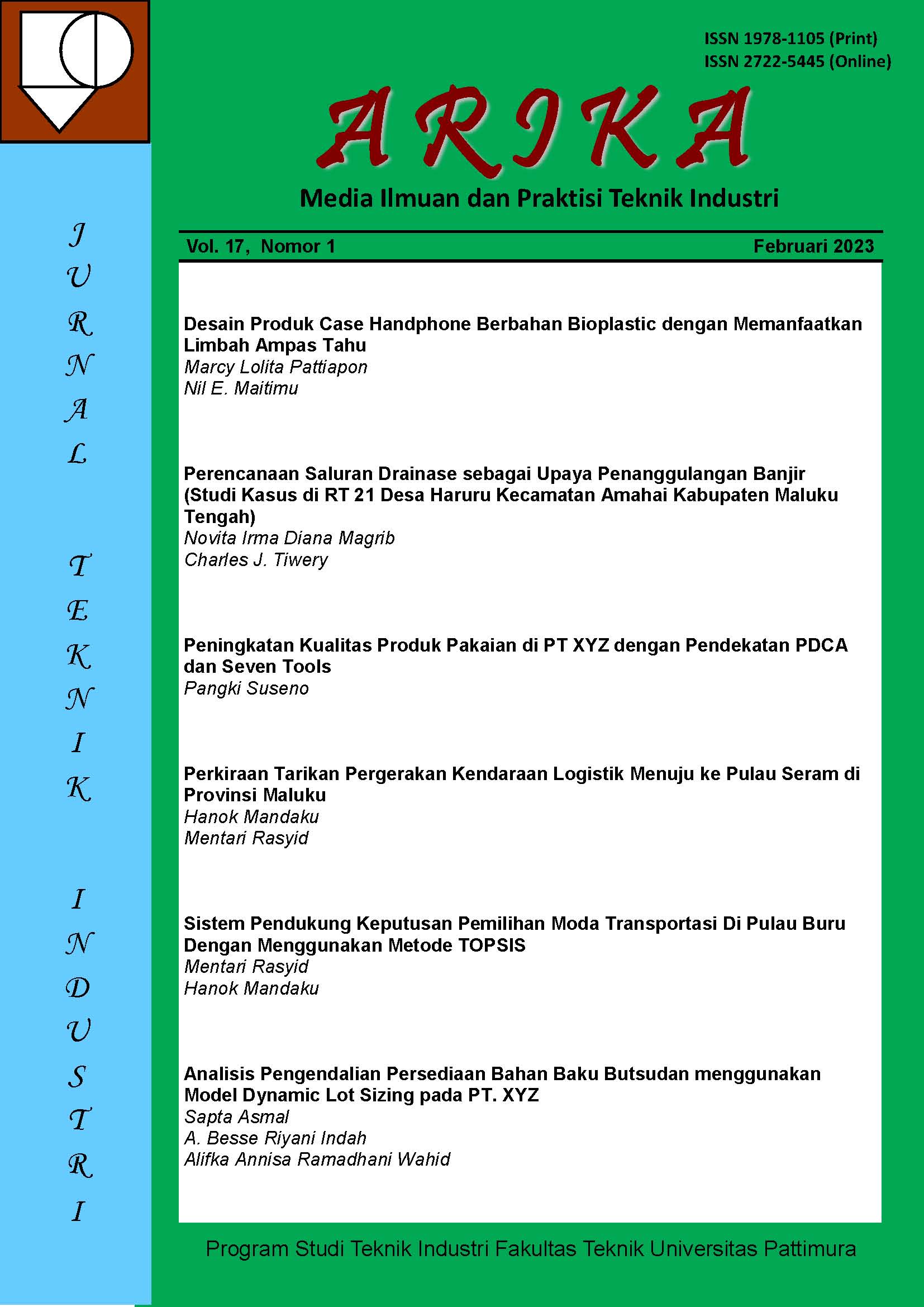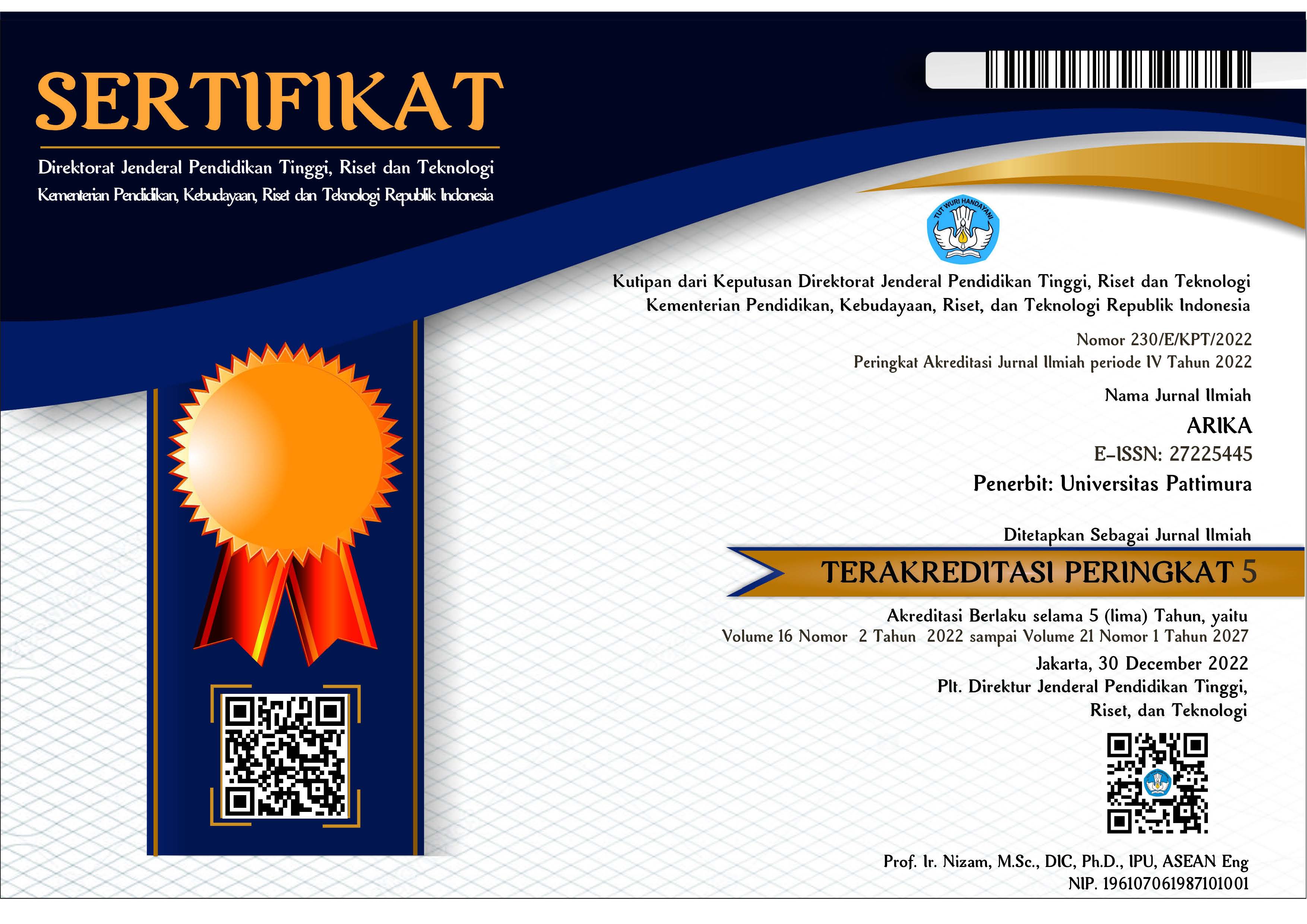Peningkatan Kualitas Produk Pakaian di PT XYZ dengan Pendekatan PDCA dan Seven Tools
Abstract
PT XYZ adalah perusahaan manufaktur pakaian. Beberapa faktor menjadi rintangan yang menghasilkan cacat produk selama proses manufaktur, sehingga menghasilkan tingkat cacat produk yang relatif tinggi. Metode PDAC adalah alat yang memfasilitasi pendeteksian peluang peningkatan, serta pengembangan dan implementasi yang sama dalam proses produksi dan seven tools merupakan alat yang membantu quality control untuk memecahkan masalah pada produk yang ada. tujuan studi ini adalah untuk menentukan jenis-jenis cacat, akar penyebabnya, dan langkah – langkah untuk mengurangi jumlah cacat. Berdasarkan hasil pembahasan, total produksi sebanyak 26.071 pcs dengan 2.138 kesalahan. Cacat dengan persentase tertinggi adalah cacat kain yaitu sebesar 36,2%. Perbaikan tersebut antara lain pemeriksaan material secara berkala untuk menjaga kualitas material, perbaikan mesin secara berkala untuk menghindari hilangnya kualitas produksi, dan menyusun SOP proses produksi yang berkualitas dan akurat.
Downloads
References
Abdel - Hamid, M., & Abdelhaleem, H. M. (2019). Improving the Construction Industry Quality Using the Seven Basic Quality Control Tools. Journal of Minerals and Materials Characterization and Engineering, 07(06), 412–420. https://doi.org/10.4236/jmmce.2019.76028
Assauri, S. (2008). Manajemen Produksi dan Operasi. Fakultas Ekonomi Universitas Indonesia.
Cano, E. L., Moguerza, J. M., & Corcoba, M. P. (2015). The Seven Quality Control Tools in a Nutshell: R and ISO Approaches. Dalam Quality Control with R (hlm. 93–118). Springer International Publishing. https://doi.org/10.1007/978-3-319-24046-6_3
Darmawan, H., Hasibuan, S., & Hardi Purba, H. (2018). Application of Kaizen Concept with 8 Steps PDCA to Reduce in Line Defect at Pasting Process: A Case Study in Automotive Battery. International Journal of Advances in Scientific Research and Engineering, 4(8), 97–107. https://doi.org/10.31695/IJASRE.2018.32800
Hairiyah, N., Amalia, R. R., & Nuryati, N. (2020). Pengendalian Kualitas Amplang Menggunakan Seven Tools di UD. Kelompok Melati. AGROINTEK, 14(2), 249–257. https://doi.org/10.21107/agrointek.v14i2.6055
Harahap, B., & Parinduri, L. (2018). Analisis Pengendalian Kualitas dengan Menggunakan Metode Six Sigma. Buletin Utama Teknik, 13(3), 211–219.
Heryadi, A. R., & Sutopo, W. (2018). Review Pemanfaatan Metodologi DMAIC Analysis di Industri Garmen. Seminar dan Konferensi Nasional IDEC.
Isniah, S., Hardi Purba, H., & Debora, F. (2020). Plan do check action (PDCA) method: Literature review and research issues. Jurnal Sistem dan Manajemen Industri, 4(1), 72–81. https://doi.org/10.30656/jsmi.v4i1.2186
Montgomery, D. C. (1995). Pengantar Pengendalian Kualitas Statistik. Gadjah Mada University Press.
Ratnadi, & Suprianto, E. (2016). Pengendalian Kualitas Produksi Menggunakan Alat Bantu Statistik (Seven Tools) dalam Upaya Menekan Tingkat Kerusakan Produk. INDEPT, 6(2), 10–18.
Realyvásquez-Vargas, A., Arredondo-Soto, K., Carrillo-Gutiérrez, T., & Ravelo, G. (2018). Applying the Plan-Do-Check-Act (PDCA) Cycle to Reduce the Defects in the Manufacturing Industry. A Case Study. Applied Sciences, 8(11), 2181. https://doi.org/10.3390/app8112181
Suseno, P., & Sudarso, I. (2021). Peningkatan Kualitas Produk Gamis Anak di PT.KKI dengan Metode Quality Function Deployment dan Six Sigma. Seminar Nasional Teknologi Industri Berkelanjutan I (SENASTITAN I), 144–150.
Taherdoost, H. (2016). Sampling Methods in Research Methodology; How to Choose a Sampling Technique for Research. SSRN Electronic Journal. https://doi.org/10.2139/ssrn.3205035
Copyright (c) 2023 Pangki Suseno

This work is licensed under a Creative Commons Attribution-ShareAlike 4.0 International License.
An author who publishes in the ARIKA Jurnal agrees to the following terms:
- The author retains the copyright and grants ARIKA journal the right of first publication of the work simultaneously licensed under the Creative Commons Attribution-ShareAlike 4.0 License that allows others to share the work with an acknowledgment of the work's authorship and initial publication in this journal.
- The author is able to enter into separate, additional contractual arrangements for the non-exclusive distribution of the journal's published version of the work (e.g., post it to an institutional repository or publish it in a book) with the acknowledgment of its initial publication in this journal.
- The author is permitted and encouraged to post his/her work online (e.g., in institutional repositories or on their website) prior to and during the submission process, as it can lead to productive exchanges, as well as earlier and greater citation of the published work (See The Effect of Open Access).










